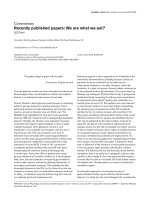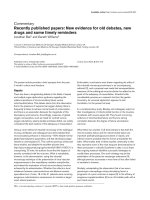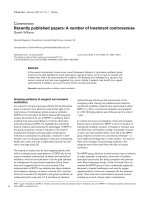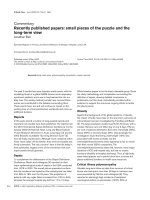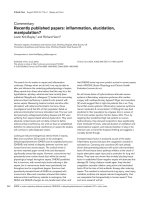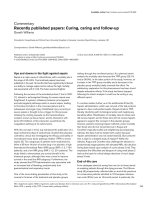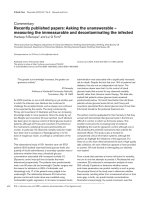Báo cáo khoa học: "Recently published papers: Curing, caring and follow-up" pot
Bạn đang xem bản rút gọn của tài liệu. Xem và tải ngay bản đầy đủ của tài liệu tại đây (38.79 KB, 3 trang )
339
HS = hypertonic saline; HSD = hypertonic saline and dextran; ICU = intensive care unit; IH = induced hypothermia; INR = International Normalised
Ratio; QOL = quality of life; TFPI = tissue factor pathway inhibitor.
Available online />Ups and downs in the fight against sepsis
Sepsis is a major cause of critical illness, with a mortality rate in
the range of 30–50%. Two landmark papers have been
published in the past 18 months that have significantly furthered
our ability to manage sepsis and to reduce the high mortality
rate associated with it [1,2]. The future seemed brighter.
Following the success of the activated protein C trial in 2001
[1], interest in anticoagulant therapy for severe sepsis was
heightened. A systemic imbalance between procoagulant
and anticoagulant pathways exists in severe sepsis, leading
to thrombus formation in the microvasculature and to
subsequent end-organ injury. Endothelial injury occurring in
severe sepsis is thought to be a trigger for this process,
initiating the clotting cascade via the transmembrane
receptor, known as tissue factor, and its interaction with
factor VII. Inhibition of this interaction would block the
coagulation pathway at its earliest point.
With this concept in mind, July witnessed the publication of a
large multicentre phase 3 randomised, double-blind, placebo-
controlled, clinical trial investigating the efficacy and safety of
recombinant tissue factor pathway inhibitor (TFPI) in severe
sepsis [3]. Two subgroups of patients were randomised to
either a 96-hour infusion of active drug or to placebo: a high
International Normalised Ratio (INR) group (INR ≥ 1.2, 1754
patients), and a low INR group (INR ≤ 1.2, 201 patients). The
study failed to demonstrate any survival benefit in the
treatment groups, although there was a trend to improve
survival in the small low INR subgroup. Furthermore, the
study showed that TFPI administration was associated with
an increased risk of bleeding, predominantly from
gastrointestinal and respiratory tracts.
One of the more striking peculiarities of this study is the
reversal in fortunes of the treatment and placebo groups
halfway through the enrollment period. At a planned interim
analysis the mortality rates favoured the TFPI group (29.1%
versus 38.9%). In the latter portion of the study, however, an
increase in the TFPI group mortality and a decrease in the
placebo group mortality totally reversed this effect. No
satisfactory explanation for this phenomenon has been found
despite exhaustive efforts. If the study had been stopped
following the interim analysis I could now be writing a very
different report.
To confuse matters further, as in the antithrombin III trial [4],
heparin administration, which was not part of the trial protocol,
appears to have confounded results. Heparin binds to TFPI,
thereby interfering with its biological action and masking any
beneficial effect. Stratification of mortality rates for those who
did receive heparin and for those who did not receive heparin
appears to support this concept. In the placebo groups,
however, patients receiving heparin suffered a lower mortality
than those who did not. As pointed out in Angus and
Crowther’s typically erudite and enlightening accompanying
editorial, this data must be treated with caution because
heparin administration was not randomised [5]. But surely the
time is nigh for a detailed study of heparin? Within the
editorial, Angus and Crowther also challenge the decision to
predominantly target patients with elevated INRs, this decision
having been based upon analysis of a prior phase 2 trial. They
emphasise the difficulties and dangers of using small phase 2
trials as the basis for critical design decisions of much larger
phase 3 trials.
End-of-life care
From strategies aimed at saving lives we turn to those aimed
at assisting patients through the dying process. The Ethicus
study [6] prospectively collected data on end-of-life practices
for consecutive patients admitted to 37 European intensive
care units (ICUs) over an 18-month period. In particular, the
Commentary
Recently published papers: Curing, caring and follow-up
Gareth Williams
Consultant in Anaesthesia and Critical Care, University Hospitals of Leicester, Leicester Royal Infirmary, Leicester, UK
Correspondence: Gareth Williams,
Published online: 2 September 2003 Critical Care 2003, 7:339-341 (DOI 10.1186/cc2381)
This article is online at />© 2003 BioMed Central Ltd (Print ISSN 1364-8535; Online ISSN 1466-609X)
340
Critical Care October 2003 Vol 7 No 5 Williams
study aimed to determine the incidence and variation in the
nature of end-of-life-practices, and to describe associated
variables. The study prospectively defined five mutually
exclusive patient categories:
1 Patients having undergone unsuccessful cardiopulmonary
resuscitation.
2 Patients diagnosed with brain stem death.
3 Withholding life-sustaining treatment.
4 Withdrawing life-sustaining treatment.
5 Active shortening of the dying process.
Out of the 31,417 patients admitted to the participating ICUs
during the study period, 4248 (13.5%) died or had their
treatment limited in some way. The mean age of the study
population was only 63 years. A summary of the main results
as a percentage of the study population is presented in
Table 1.
The Ethicus study demonstrates what many of us already
know. Limitation of treatment in the critically ill is widely
practiced, although active shortening of the dying process is
rare. The majority of the reported active shortening of the
dying process practices came from a handful of centres.
Withholding usually preceded withdrawing, which preceded
active measures. Regional differences were shown, with
southern European countries practicing cardiopulmonary
resuscitation more and northern European countries
withholding and withdrawing more. Unsurprisingly, clinical
factors such as age, diagnosis and time on the ICU were
variables associated with the likelihood of treatment
limitation. Surprisingly, treatment limitation was more
probable if the physician was Catholic or Protestant rather
than Greek Orthodox, Jewish or Muslim.
This intriguing study highlights the variability in end-of-life
practices across Europe, and the many complex factors, both
objective and subjective, clinical, geographical, cultural and
religious, which contribute to the decision-making process.
For an area that many find one of the most demanding aspect
of critical care medicine the lack of consensus is disturbing,
but this trial is a significant step in the right direction.
After the ICU
Surviving a period of critical illness may seem to be the end
that justifies the means. Indeed, improvement in survival is
often the yardstick by which we judge our interventions. In
recent years, however, a growing body of evidence suggests
that for patients the story does not end at the point of leaving
the ICU alive. The quality of life (QOL) may be seriously
impaired in significant numbers of patients. But how we
identify these patients and the factors that influence to what
extent and for how long their lives are affected by critical
illness is unknown. Understanding these parameters would
surely alter the clinical decision-making processes and
enable us to better inform patients and relatives regarding
critical illness. Two prospective observational studies
published in Intensive Care Medicine, one Belgian and the
other Finnish, go some way to achieving this [7,8].
The first of these studies investigates the QOL in ICU
survivors 18 months post discharge, and the second
compares the QOL 1 year and 6 years post ICU discharge.
In the Belgian study, 38% of those who completed the
questionnaire had a worse QOL than prior to admission,
although only 8.3% were severely impaired [7]. Rather
than suffering physical disability, pain, discomfort, anxiety
and depression were the most reported QOL issues.
Severity of illness (Acute Physiology and Chronic Health
Evaluation II) and ICU readmission were associated with
increased post ICU mortality, whereas age was not. Sixty-
two per cent of respondents had returned to work at
18 months post discharge, a result consistent with other
studies.
The study from Finland compliments the Belgium study. Nine
per cent of patients at 6 years post ICU discharge
considered their health status to be very poor [8]. As might
be expected, psychological well-being had improved when
compared with 1 year post ICU discharge whereas physical
functioning had deteriorated, suggesting the existence of an
evolutionary process of post ICU morbidity. This in turn
perhaps points to the kind of therapeutic support patients
may require. The Finnish authors suggest strategies to
reduce early psychological morbidity such as keeping
patient diaries by staff and relatives to be used later as a
means of reducing patient amnesia, a well-recognised cause
of mental distress.
These two studies make it difficult to ignore the need for
comprehensive ICU follow-up and for a better understanding
of the long-term natural history of critical illness.
Table 1
Frequency of patient end-of-life categories
Cardiopulmonary Active shortening
resuscitation Brain death Withholding Withdrawing of the dying process
Patients (%) 19.6 7.8 37.5 32.9 2.2
Mortality (%) 100 100 89 99 100
341
Other papers of interest in brief
Chiara and colleagues report on the results of a laboratory
trial of resuscitation from haemorrhagic shock comparing
normal saline, dextran, hypertonic saline (HS), and a mixture
of hypertonic saline and dextran (HSD) in a porcine model
[9]. Measured parameters were the restoration of mean
arterial pressure, the aortic, mesenteric and renal blood flow,
the cardiac output, and the oxygen consumption and delivery
indices. Their main findings were:
• HS allows complete haemodynamic resuscitation using
smaller volumes.
• Resuscitation is sustained longer using HSD.
• Recovery of renal and mesenteric blood is rapid and with
no concomitant pulmonary hypertension using HSD.
• HSD maintains its haemodynamic effects longest post
cessation of fluid administration.
• Sodium concentration and osmolality were not
problematic using HS or HSD.
The theoretical advantages of HS and HSD solutions have
been recognised for some time, but we await a definitive
clinical trial.
I recommend two review articles in the July issues of Chest
and Critical Care Medicine [10,11]. Kreider and Lipson
review the evidence for the much-loved practice of
bronchoscopy in critical care patients with mucus
plugging/atelectasis. In essence, they conclude that
bronchoscopy is of use in the management of atelectasis,
particularly lobar, but there is no evidence to suggest it is
superior to less invasive techniques such as good
physiotherapy [10]. Also, bronchoscopy is associated with
potentially harmful physiological side effects such as
hypoxaemia, elevated airway pressures and raised intracranial
pressure.
Finally, in a review of the use of induced hypothermia (IH) in
critical care medicine, the physiological effects of IH and its
clinical applications are discussed [11]. Following the
excitement generated by two papers reporting the successful
use of IH in the management of prehospital cardiac arrest
[12,13], this article represents a well-balanced discussion of
the evidence for and against IH and the practical issues of its
implementation.
Competing interests
None declared.
References
1. Bernard GR, Vincent JL, Laterre PF, LaRosa SP, Dhainault JF,
Lopez-Rodriguez A, Steingrub JS, Garber GE, Helterbrand JD, Ely
EW, Fisher CJ Jr, Recombinant Human Protein C Worldwide Eval-
uation in Severe Sepsis (PROWESS) Study Group: Efficacy and
safety of recombinant human activated protein C for severe
sepsis. N Engl J Med 2001, 344:699-709.
2. Rivers E, Nguyen B, Havstad S, Ressler J, Muzzin A, Knoblich B,
Peterson E, Tomlanovitch M, Early Goal-Directed Therapy Collab-
orative Group: Early goal-directed therapy in the treatment of
severe sepsis and septic shock. N Engl J Med 2001, 345:
1368-1377.
3. Abraham E, Reinhart K, Opal S, Demeyer I, Doig C, Rodriguez AL,
Beale R, Svoboda P, Laterre PF, Simon S, Light B, Spapen H,
Stone J, Seibert A, Peckelsen C, De Deyne C, Postier R, Petilla V,
Sprung C, Artigas A, Percell SR, Shu V, Zwingelstein C, Tobias J,
Poole L, Stolzenbach JC, Creasey AA, for the OPTIMIST Trial
Study Group: Efficacy and safety of tifacogin (recombinant
tissue factor pathway inhibitor) in severe sepsis. JAMA 2003,
290:238-247.
4. Warren BL, Eid A, Singer P, Pillay SS, Carl P, Novak I, Chalupa P,
Atherstone A, Penzes I, Kubler A, Knaub S, Keinecke HO, Hein-
richs H, Schindel F, Juers M, Bone RC, Opal SM; KyberSept Trial
Study Group. Caring for the critically ill patient. High-dose
antithrombin III in severe sepsis: a randomized controlled
trial. JAMA 2001, 286:1869-1878.
5. Angus DC, Crowther MA: Unraveling severe sepsis. Why did
OPTIMIST fail and what’s next? JAMA 2003, 290:256-258.
6. Sprung CL, Cohen SL, Sjokvist P, Baras M, Bulow HH, Hovilehto
S, Ledoux D, Lippert A, Maia P, Phelan D, Schobersberger W,
Wennberg E, Woodcock T, for the Ethicus Study Group: End-of-
life practices in European intensive care units. JAMA 2003,
290:790-797.
7. Lizana FG, Bota DP, De Cubber M, Vincent JL: Long-term
outcome in ICU patients: what about quality of life? Intensive
Care Med 2003, 29:1286-1293.
8. Kaarlola A, Petilla V, Kekki P: Quality of life six years after inten-
sive care. Intensive Care Med 2003, 29:1294-1299.
9. Chiara O, Pelosi P, Brazzi L, Bottino N, Taccone P, Climbanassi
S, Segala M, Gattinoni L, Scalea T: Resuscitation from haemor-
rhagic shock: experimental model comparing saline, dextran,
and hypertonic saline solutions. Crit Care Med 2003, 31:1915-
1922.
10. Kreider ME, Lipson DA: Bronchoscopy for atelectasis in the
ICU. A case report and review of the literature. Chest 2003,
124:344-350.
11. Bernard SA, Buist M: Induced hypothermia in critical care
medicine: a review. Crit Care Med 2003, 31:2041-2051.
12. Bernard SA, Gray TW, Buist MD, Jones BM, Silvester W, Gut-
teridge G, Smith K: Treatment of comatose survivors of out-of-
hospital cardiac arrest with induced hypothermia. N Engl J
Med 2002, 346:557-563.
13. The Hypothermia After Cardiac Arrest Study Group: Mild thera-
peutic hypothermia to inprove outcome after cardiac arrest.
N Engl J Med 2003, 346:549-556.
Available online />

